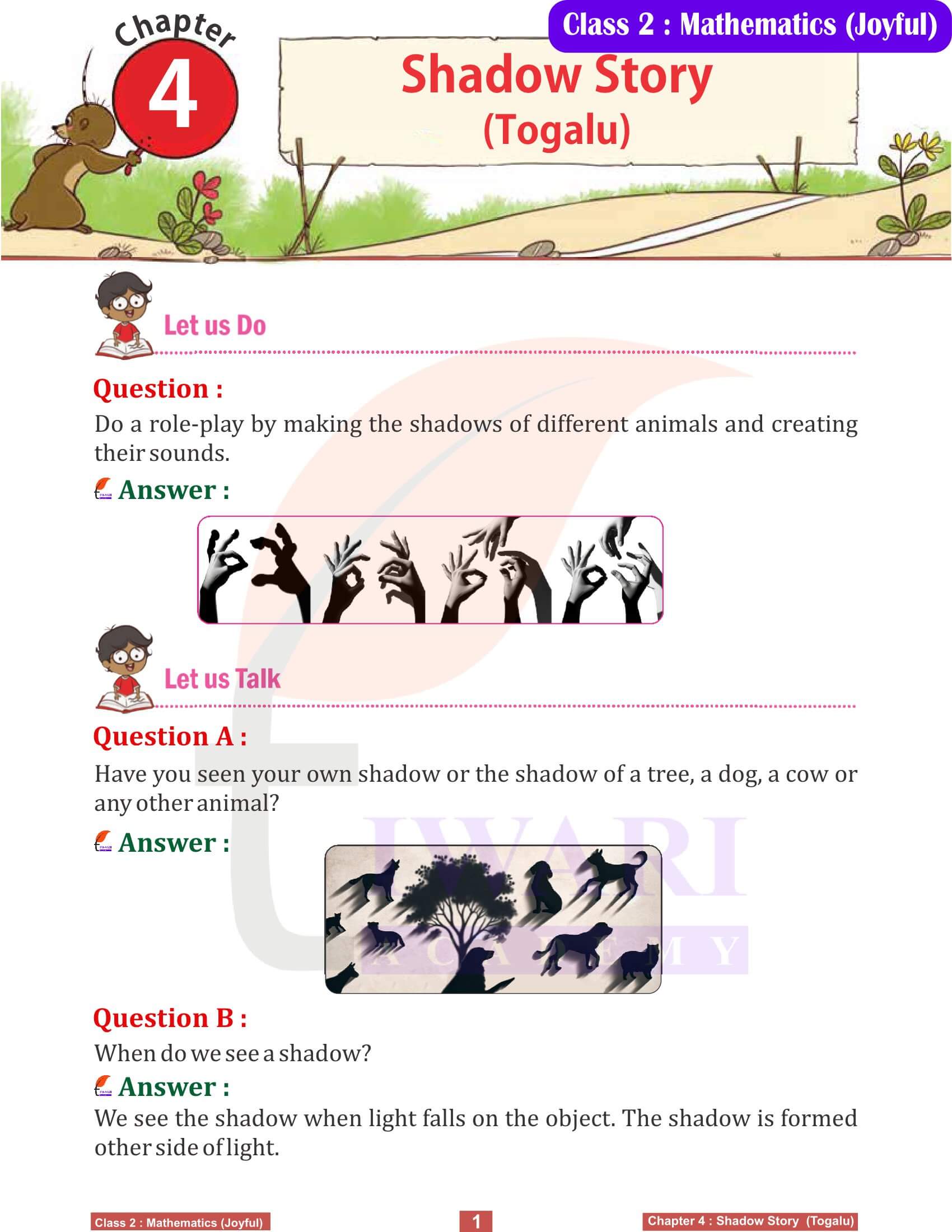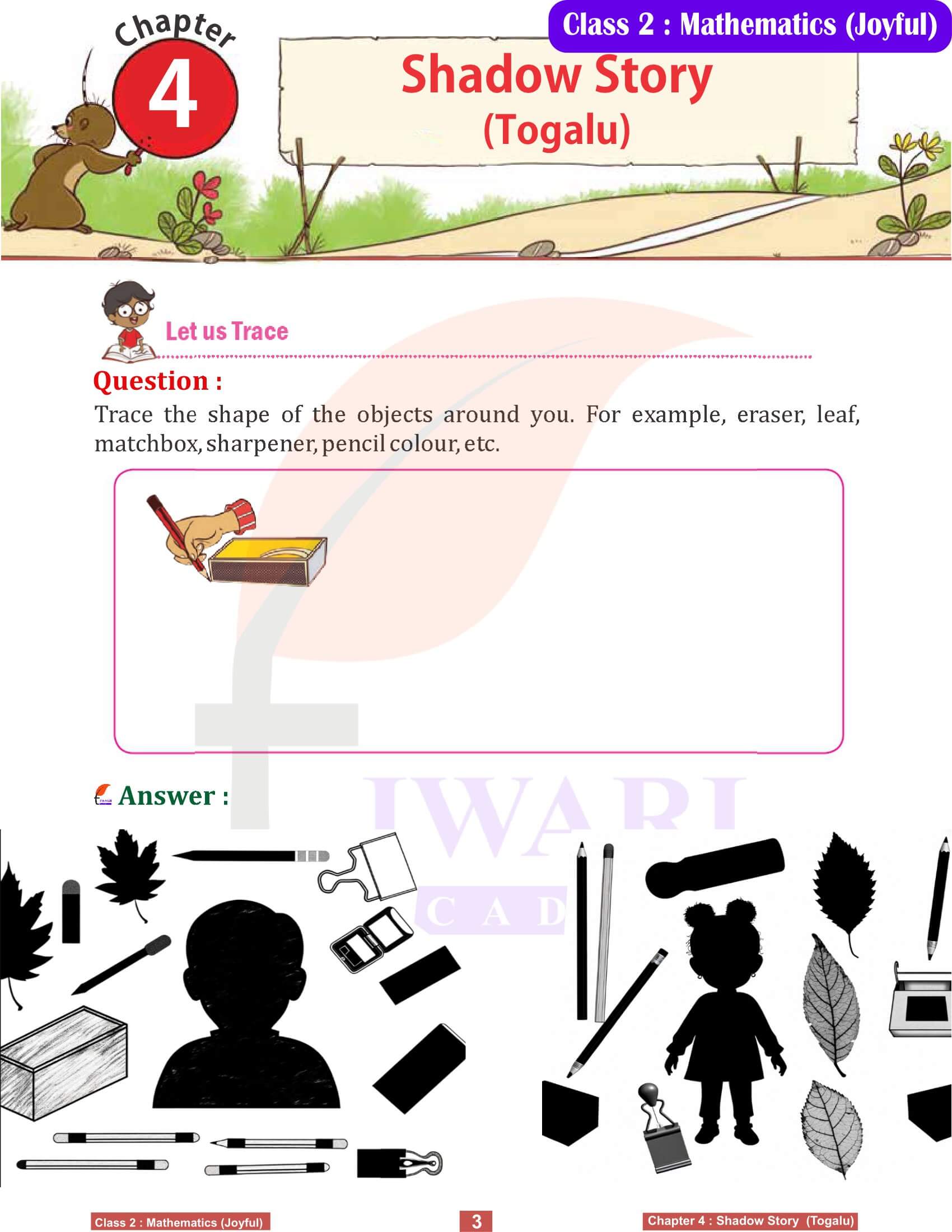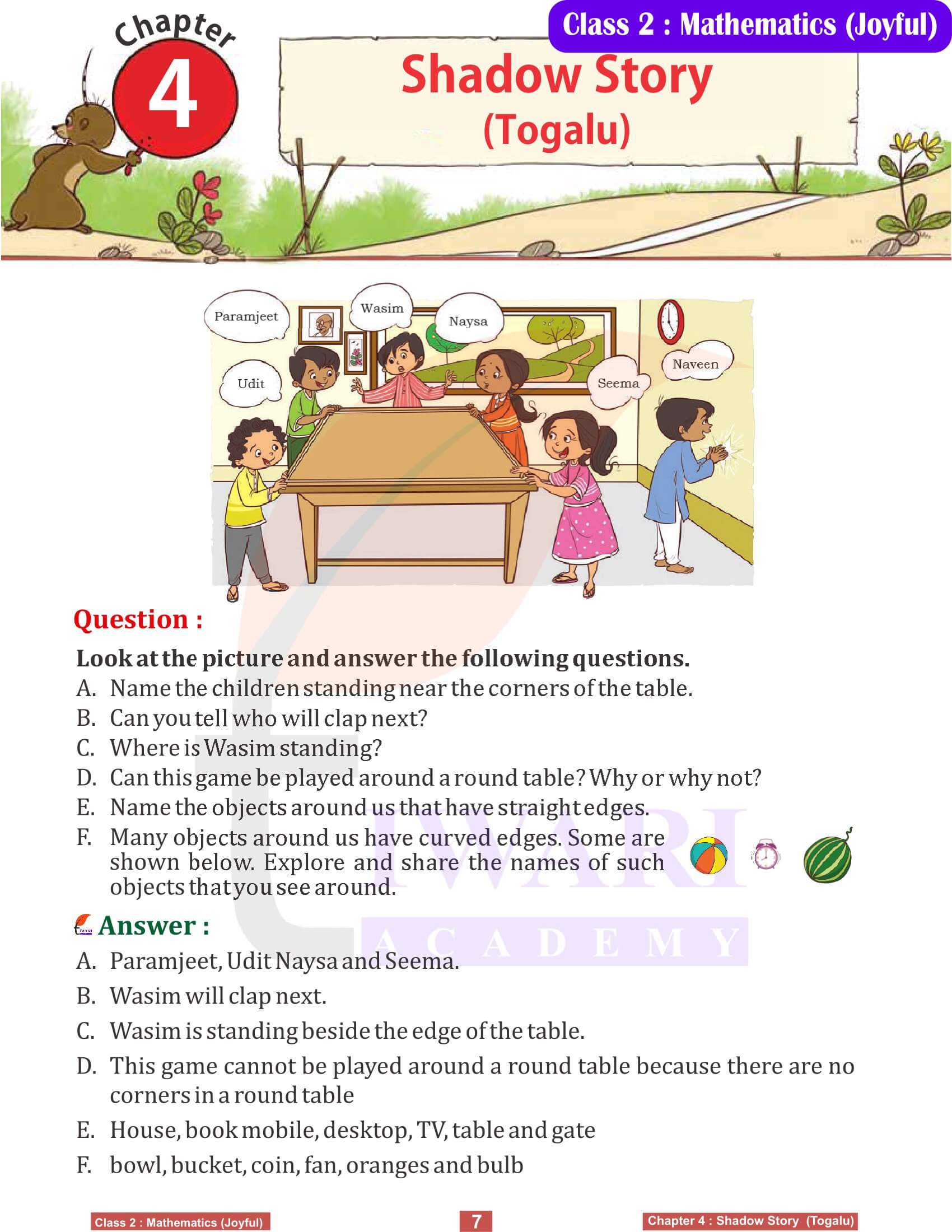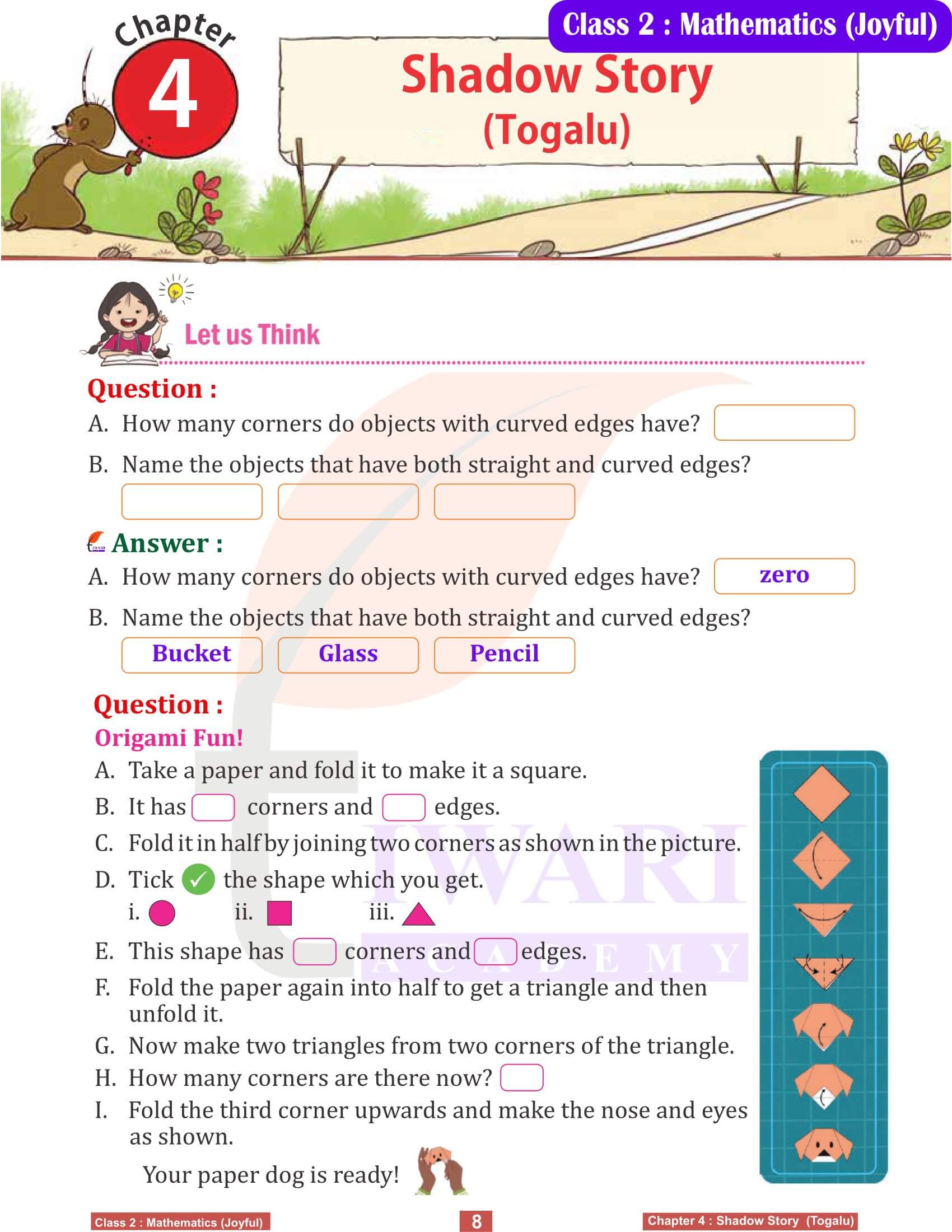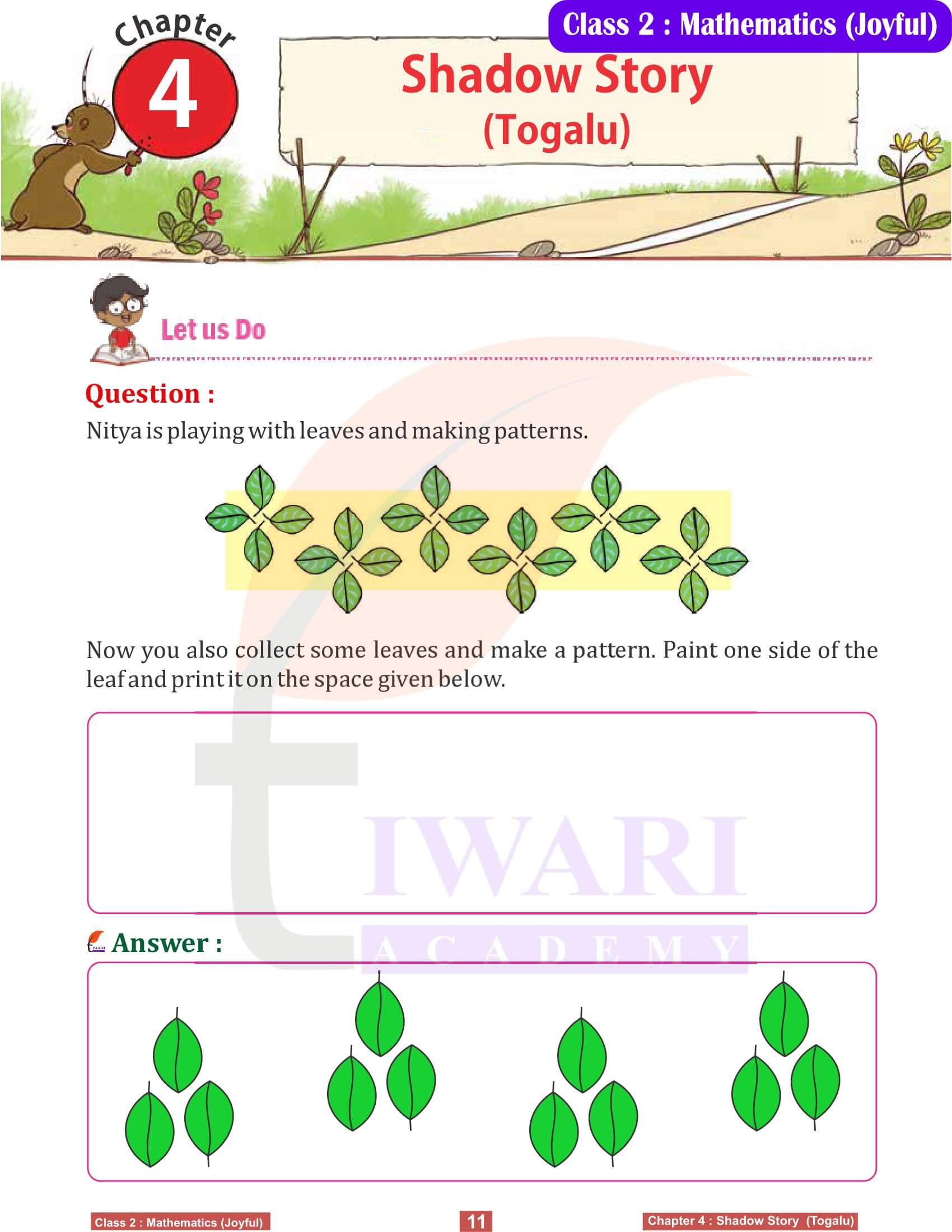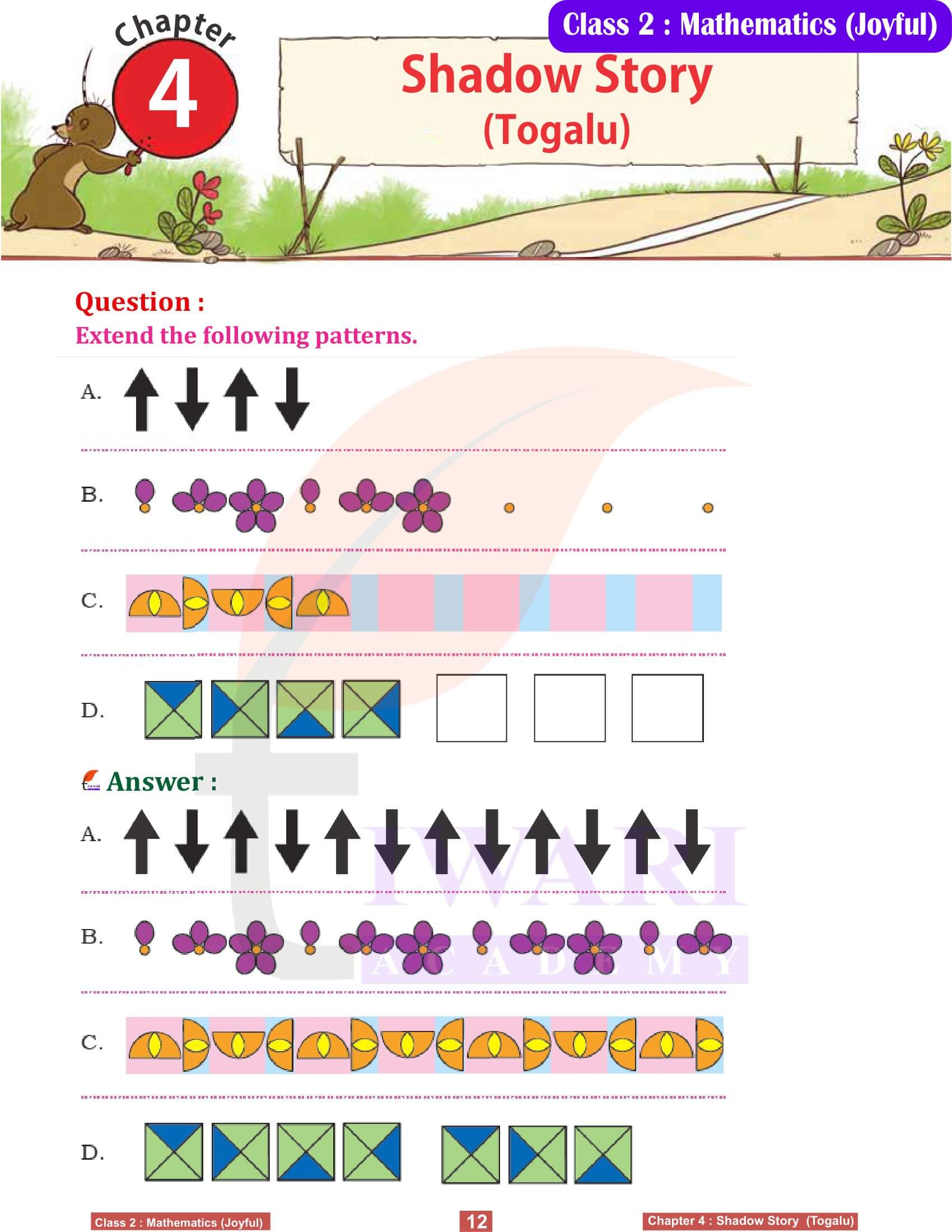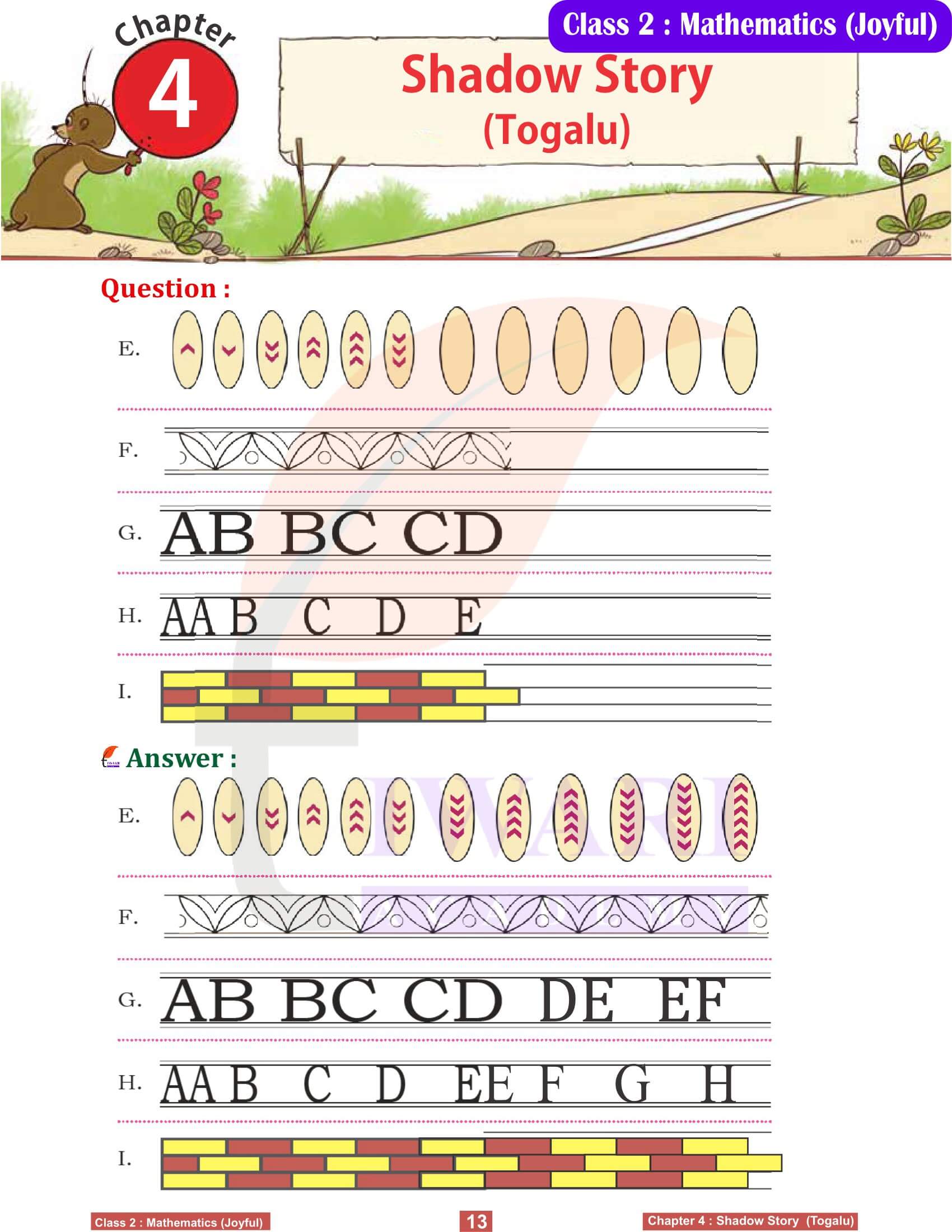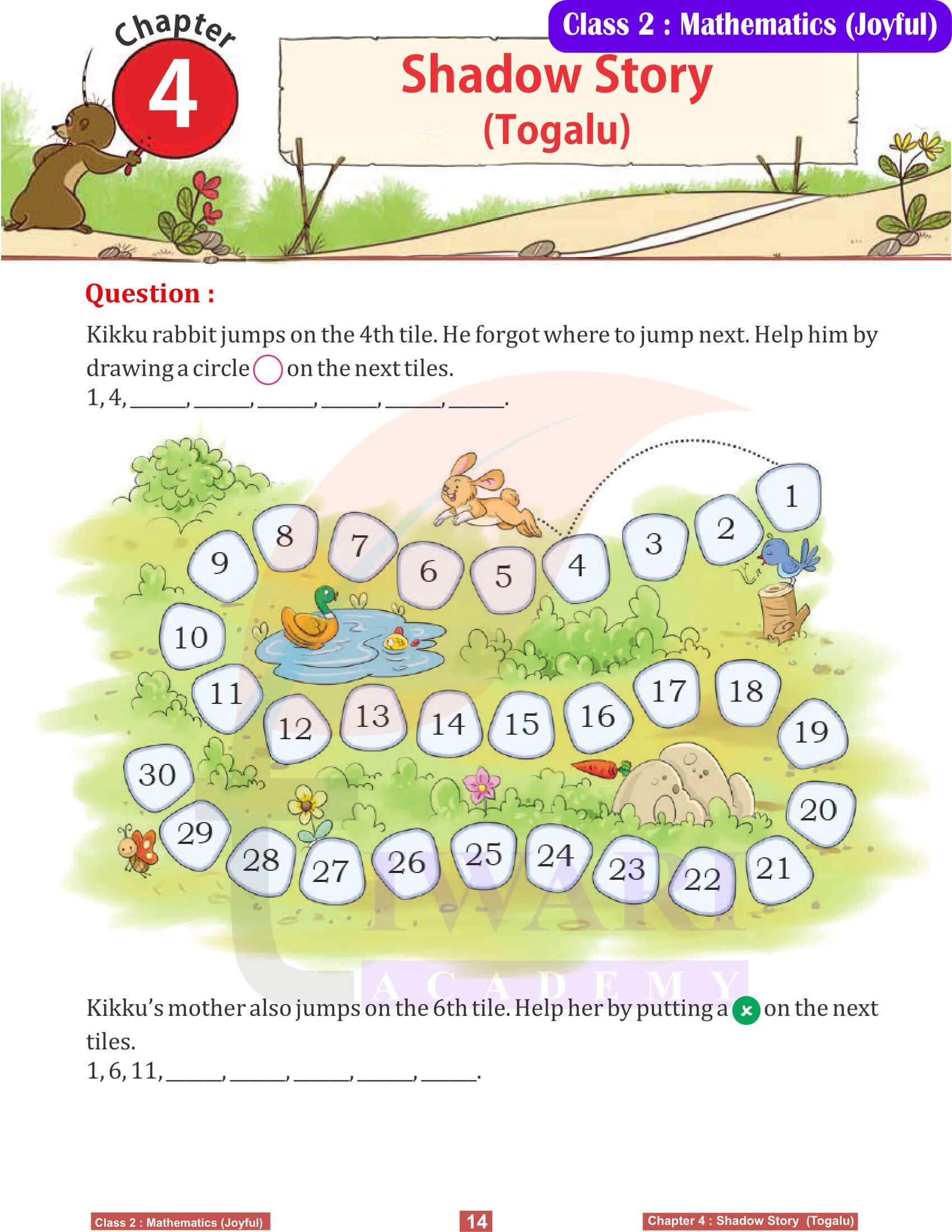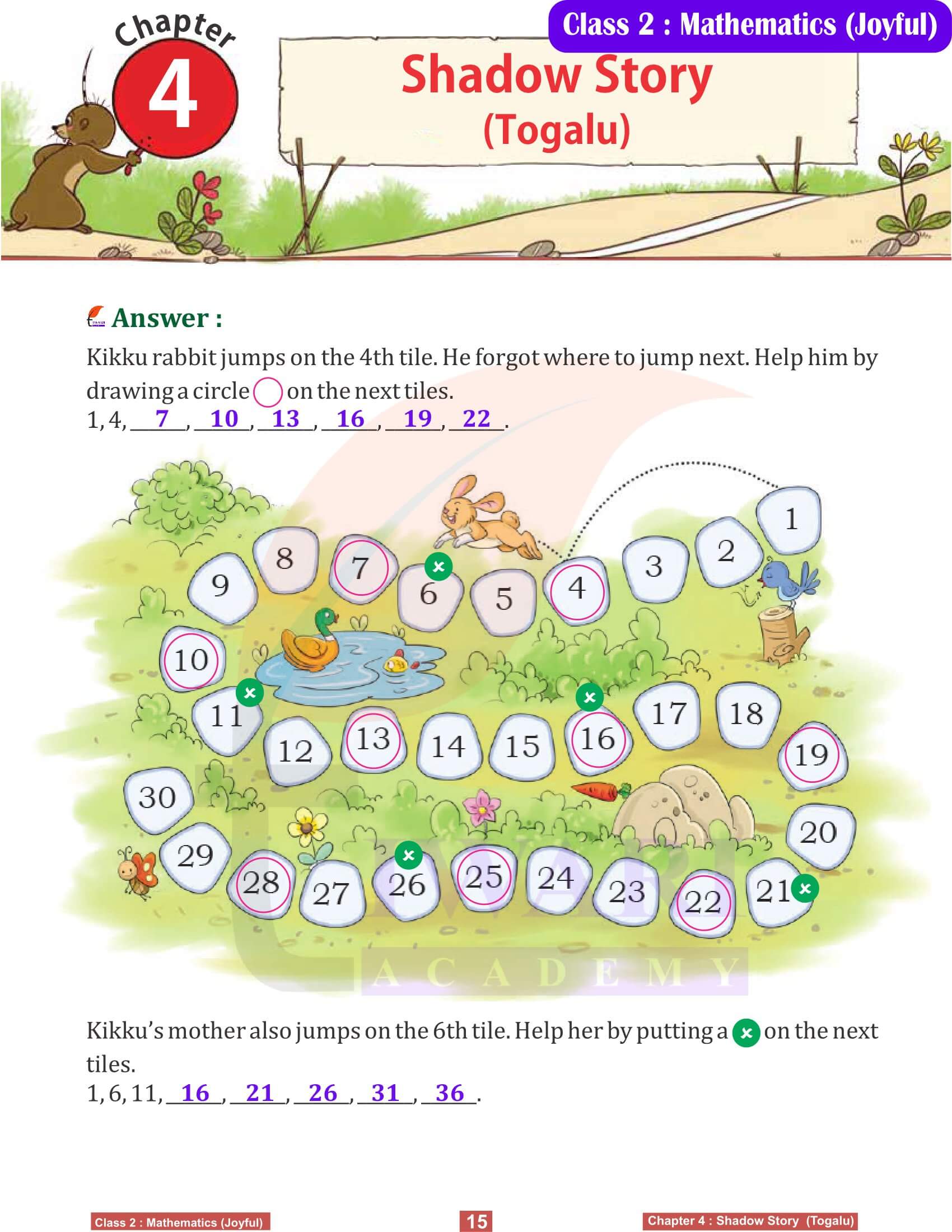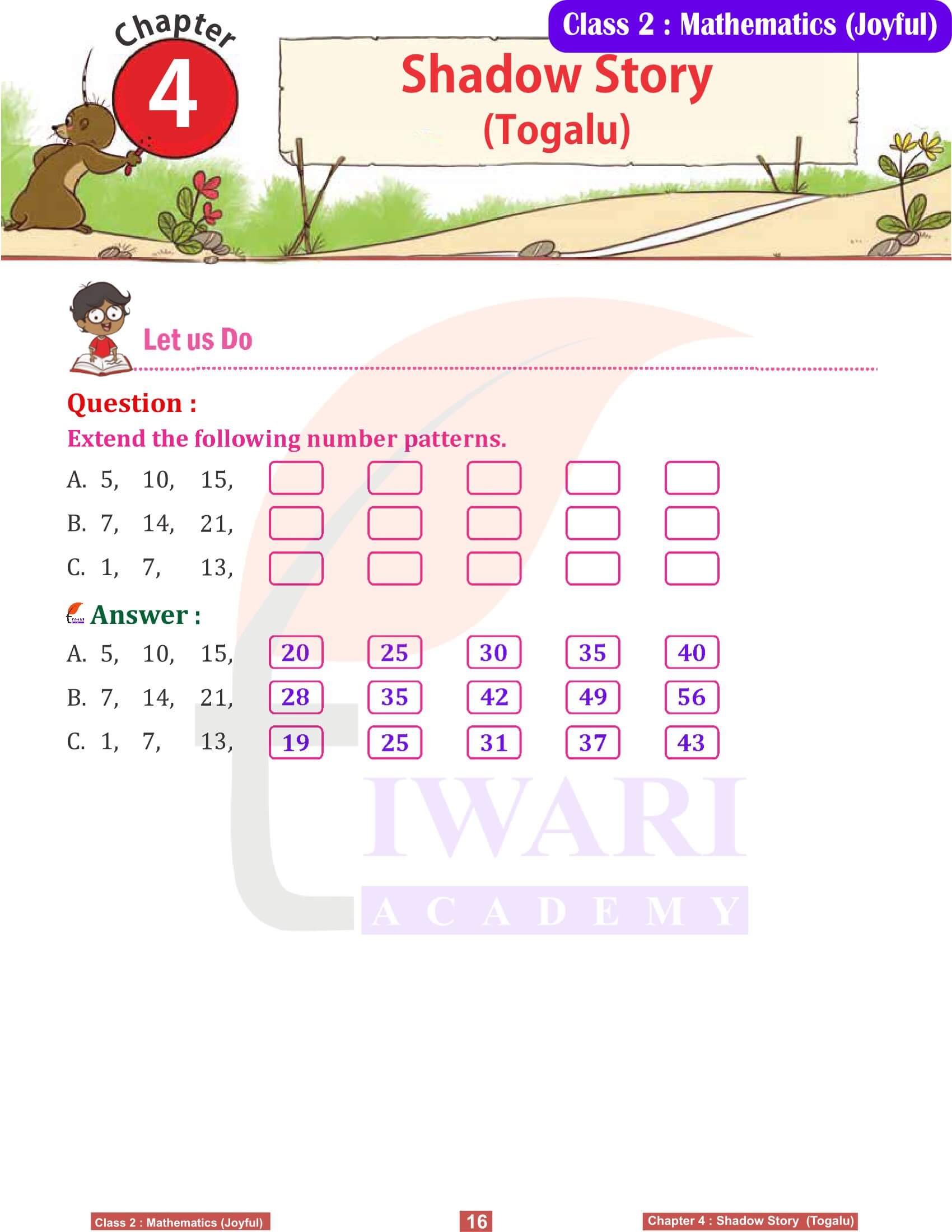NCERT Solutions for Class 2 Joyful Maths Chapter 4 Shadow Story (Togalu) (2D Shapes) in Hindi and English Medium revised for NEP 2020. Class 2 Maths chapter 4 solutions are updated for academic session 2025-26 in simple format. NCERT Class 2 Mathematics Textbook Chapter 4, Shadow Story (Togalu), introduces young learners to the fascinating world of 2D shapes through engaging and interactive activities. The chapter blends cultural storytelling with educational concepts, utilizing Togalu Gombeyaata, a traditional form of shadow puppetry, to teach the formation and recognition of shapes like circles, squares and triangles.
Class 2 Joyful Maths Chapter 4 Shadow Story Solutions
By connecting shadows to real-life objects, students understand the importance of spatial skills while learning about their cultural heritage. Teachers can enhance learning with worksheets, question-answers, and lesson plans designed to reinforce key concepts. NCERT Textbook solutions for Class 2 Math Chapter 4 provide a structured approach to mastering this topic while making education enjoyable.
Study Plan for Class 2 Mathematics
Study Plan for Class 2 Examinations
To make learning exciting, Class 2 Maths Book Chapter 4 incorporates interactive activities such as creating shadows with everyday objects to explore 2D shapes. Resources like PDFs, educational videos and assessment questions help teachers craft a comprehensive lesson plan for their students. By integrating shadow puppetry from the Togalu tradition, the chapter also highlights the importance of blending cultural awareness with modern education. Interactive worksheets and fun learning methods further reinforce concepts, making 2D shapes relatable and memorable. This approach not only builds foundational math skills but also enhances creativity, curiosity and a deeper understanding of the cultural context within the curriculum.
Class 2 Maths Chapter 4 Shadow Story (Togalu) (2D Shapes)
The chapter ‘Shadow Story (Togalu)’ in Class 2 Mathematics introduces young learners to the enchanting world of shadows and shapes, using the traditional art form of shadow puppetry as a captivating backdrop. This innovative approach not only makes learning more interactive but also bridges the gap between cultural heritage and mathematical concepts. Through the story, students are encouraged to observe and identify various 2D shapes that form part of our daily lives, linking them with the silhouettes and figures seen in Togalu Gombeyaata, a form of shadow puppetry popular in southern India.
Understanding 2D Shapes
In this chapter 4 of class 2 mathematics, children explore the basic properties and types of 2D shapes like circles, squares, rectangles, triangles, and more. They learn how these shapes are everywhere around us, from windows and books to clocks and plates. The narrative cleverly integrates these shapes into the story-line of the shadow puppet show, prompting students to identify and distinguish between the various forms. This hands-on approach aids in the recognition and understanding of shapes, enhancing their spatial reasoning skills.
The Magic of Shadows
Delving deeper into the ‘Shadow Story’, the chapter elucidates how shadows are formed and the role light plays in this fascinating phenomenon. Kids discover how blocking light creates shadows and how these shadow shapes can represent different 2D shapes. They are encouraged to experiment with light sources and objects, observing how the distance and angle of light alter the size and shape of shadows, thereby reinforcing their understanding of geometry in a playful and engaging way.
Storytelling with Shapes
The core of class 2 Maths chapter 4, lies in using storytelling to deepen the children’s grasp of mathematical concepts. The Togalu shadow story unfolds, integrating various characters and scenes made up of 2D shapes. As the plot progresses, students are tasked with identifying these shapes, enhancing their learning through narrative context. This method not only makes the learning process enjoyable but also aids in memory retention and the ability to relate mathematical concepts to real-world scenarios.
Interactive Learning Activities
To reinforce the concepts learned, the chapter includes a variety of interactive activities and exercises. Students engage in crafting their own shadow puppets using 2D shapes, orchestrating mini shadow plays, and even participating in quizzes and games that challenge them to identify and create different shapes. These activities cater to diverse learning styles and ensure that students can apply what they have learned in a practical, hands-on manner.
The chapter, students reflect on the importance of shapes in both art and everyday life, understanding how mathematics is not just limited to numbers but is intricately linked to the world around us. They are encouraged to observe their environment through a mathematical lens, spotting and identifying 2D shapes.
The chapter 4 of 2nd mathematics, not only lays the foundation for geometry but also instills an appreciation for the interplay between mathematics, art, and culture, fostering a holistic educational experience.
How does Class 2 Maths Chapter 4, Shadow Story (Togalu), help students learn about 2D shapes?
Class 2 Maths Chapter 4 introduces 2D shapes using shadow puppetry, specifically inspired by Togalu Gombeyaata, a traditional art form. By exploring how shadows of different objects form shapes like circles, squares and triangles, students develop spatial awareness and foundational geometry skills. The chapter includes interactive activities, relatable examples and cultural storytelling, making learning engaging and fun. Worksheets, NCERT solutions and lesson plans further support understanding. This approach ensures students not only learn mathematical concepts but also appreciate cultural heritage, fostering creativity and curiosity.
What resources can teachers use to teach Shadow Story (Togalu) effectively?
Teachers can enhance lessons on Shadow Story (Togalu) with NCERT solutions, interactive worksheets and lesson plans that emphasize 2D shapes and shadow formation. Educational videos and cultural storytelling elements like Togalu Gombeyaata provide engaging ways to introduce the topic. Activities involving shadows and everyday objects make learning relatable for students. PDFs and assessment questions are excellent tools for reinforcing concepts and tracking progress. These resources create a well-rounded learning experience, helping students grasp math fundamentals while appreciating the cultural significance of shadow puppetry.
What is the most interesting impact in Class 2 Maths Chapter 4?
The most interesting impact of Class 2 Maths Chapter 4, Shadow Story (Togalu), is its ability to blend cultural heritage with foundational math concepts. By using Togalu Gombeyaata, a traditional shadow puppetry art form, the chapter transforms learning into a creative and immersive experience. Students not only understand 2D shapes like circles, squares, and triangles but also develop spatial awareness through relatable, real-world activities. This unique approach sparks curiosity, enhances creativity and instills an appreciation for cultural traditions, making math enjoyable and meaningful for young learners.
What is the purpose of learning Class 2 Joyful Maths Chapter 4?
The purpose of learning Class 2 Joyful Maths Chapter 4, Shadow Story (Togalu), is to introduce students to the concept of 2D shapes and spatial awareness in an engaging and meaningful way. Through activities involving shadows and storytelling inspired by Togalu Gombeyaata, a traditional form of shadow puppetry, the chapter combines cultural appreciation with foundational math skills. It encourages students to explore shapes like circles, squares, and triangles in real-world contexts while fostering creativity and curiosity. This approach not only builds mathematical understanding but also connects students to cultural heritage, making learning joyful and impactful.
